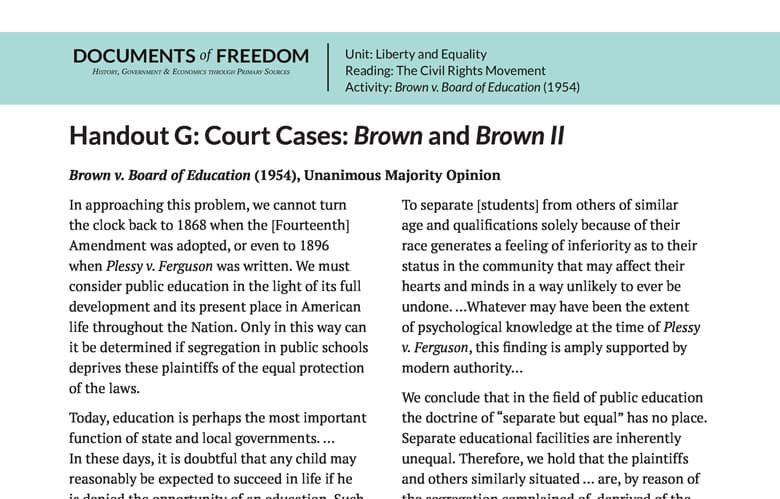Handout G: Court Cases: Brown and Brown II
Handout G: Court Cases: Brown and Brown II
Brown v. Board of Education (1954), Unanimous Majority Opinion
In approaching this problem, we cannot turn the clock back to 1868 when the [Fourteenth] Amendment was adopted, or even to 1896 when Plessy v. Ferguson was written. We must consider public education in the light of its full development and its present place in American life throughout the Nation. Only in this way can it be determined if segregation in public schools deprives these plaintiffs of the equal protection of the laws.
Today, education is perhaps the most important function of state and local governments. … In these days, it is doubtful that any child may reasonably be expected to succeed in life if he is denied the opportunity of an education. Such an opportunity, where the state has undertaken to provide it, is a right which must be made available to all on equal terms…
To separate [students] from others of similar age and qualifications solely because of their race generates a feeling of inferiority as to their status in the community that may affect their hearts and minds in a way unlikely to ever be undone. …Whatever may have been the extent of psychological knowledge at the time of Plessy v. Ferguson, this finding is amply supported by modern authority…
We conclude that in the field of public education the doctrine of “separate but equal” has no place. Separate educational facilities are inherently unequal. Therefore, we hold that the plaintiffs and others similarly situated … are, by reason of the segregation complained of, deprived of the equal protection of the laws guaranteed by the Fourteenth Amendment.
- How did the Brown decision overturn Plessy v. Ferguson (Handout D) Majority Opinion?
- On what grounds did the Court base its decision?
- How does the Fourteenth Amendment (Handout C) provide a basis for this decision?
Brown II (1955), Majority Opinion
Note: After the 1954 decision in Brown v. Board of Education declared state mandated segregation in public schools unconstitutional, the case was reargued to determine how to correct the violations.
[T]he cases are remanded to the District Courts to take such proceedings and enter such orders and decrees consistent with this opinion as are necessary and proper to admit to public schools on a racially nondiscriminatory basis with all deliberate speed the parties to these cases.
- What did the Supreme Court order the District Courts to do?
- How does this document reveal the Court’s dependence on other branches and levels of government for enforcement of its decisions?
